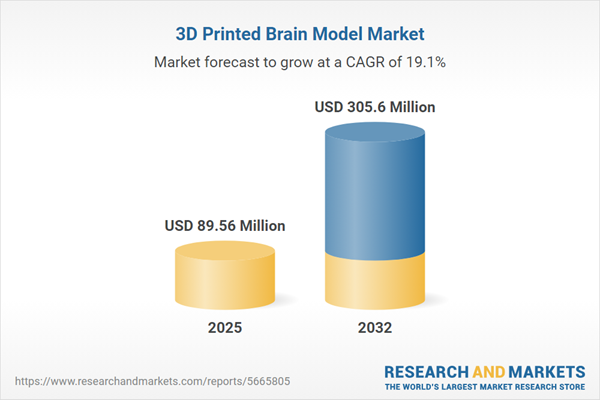Speak directly to the analyst to clarify any post sales queries you may have.
The 3D Printed Brain Model Market is rapidly advancing, enabling transformative change across clinical, educational, and device development workflows. Senior healthcare leaders, procurement professionals, and innovation strategists are increasingly recognizing the operational and clinical value these technologies deliver throughout their organizations.
Market Snapshot: 3D Printed Brain Model Market Growth and Dynamics
The 3D Printed Brain Model Market grew from USD 75.26 million in 2024 to USD 89.56 million in 2025. It is expected to continue growing at a CAGR of 19.14%, reaching USD 305.60 million by 2032. This robust expansion signals accelerating adoption across hospitals, device manufacturers, and research institutions worldwide, driven by advancements in imaging, materials, and scalable production workflows.
Scope & Segmentation
- Material: Acrylonitrile Butadiene Styrene, Metal Powders, Photopolymer Resin, Polylactic Acid
- Technology: Binder Jetting, Digital Light Processing, Fused Deposition Modeling (Composite Filament, Standard Thermoplastic), Selective Laser Sintering, Stereolithography (Biocompatible Resin, Standard Resin)
- Application: Device Testing, Implant Design, Medical Education (Anatomical Models, Training Simulators), Research, Surgical Planning (Cranial Models, Tumor Resection Models, Vascular Models)
- End User: Educational Institutes, Hospitals and Clinics, Medical Device Manufacturers, Research Laboratories
- Region: Americas (North America: United States, Canada, Mexico; Latin America: Brazil, Argentina, Chile, Colombia, Peru), Europe, Middle East & Africa (Europe: United Kingdom, Germany, France, Russia, Italy, Spain, Netherlands, Sweden, Poland, Switzerland; Middle East: United Arab Emirates, Saudi Arabia, Qatar, Turkey, Israel; Africa: South Africa, Nigeria, Egypt, Kenya), Asia-Pacific (China, India, Japan, Australia, South Korea, Indonesia, Thailand, Malaysia, Singapore, Taiwan)
- Key Companies: 3D Systems, Inc., Stratasys Ltd., Materialise NV, GE Healthcare Technologies, Inc., Siemens Healthineers AG, Renishaw plc, Protolabs, Inc., SLM Solutions Group AG, HP Inc., Desktop Metal, Inc.
Key Takeaways for Senior Decision Makers
- 3D printed brain models have moved from proof-of-concept to essential workflow tools, enabling improved preoperative visualization, precision device validation, and structured medical education.
- Advanced materials and new imaging-to-print workflows allow for models with realistic tissue-mimicking properties and patient-specific anatomical detail. Selection of materials like photopolymer resin or polylactic acid can impact clinical suitability and cost-effectiveness.
- Accessible printing technologies and biocompatible materials reduce technical barriers, enabling both in-house prototyping and effective external collaboration for hospitals, clinics, and research facilities.
- Segmentation by application and end-user clarifies unique value drivers: hospitals prioritize clinical accuracy, educators seek anatomical realism for training, and medical device firms focus on reproducibility and regulatory traceability.
- Cross-disciplinary partnerships and integration between imaging, modeling, and printing teams foster faster innovation cycles and enhanced clinical adoption.
- Tailored offerings and flexible supplier arrangements are increasingly important in meeting varied institutional requirements and ensuring traceable, validated models for regulated settings.
Tariff Impact on Supply Chains and Adoption Pathways
Recent tariff adjustments in the United States have added complexity to supply chain strategies for imported materials and printer components. Organizations are responding by diversifying suppliers, investing in regional and domestic sources, and re-evaluating inventory buffers. These adaptations support continuity in production and help limit lead-time risk while emphasizing cost stability. The push for local sourcing aligns with the need for rapid turnaround in patient-specific applications and compliance with evolving regulatory requirements.
Methodology & Data Sources
This report combines structured interviews with clinical and technical experts, direct site observations in manufacturing and hospital settings, and systematic reviews of peer-reviewed literature and standards. Segmentation analysis, robustness checks through scenario planning, and peer validation ensure actionable, reliable conclusions throughout the market assessment.
Why This Report Matters
- Equips decision-makers with a detailed segmentation of materials, technologies, applications, and end-user needs, enabling targeted investment and procurement strategies in the 3D Printed Brain Model Market.
- Offers clarity on regulatory influences, regional adoption patterns, and supply chain resilience, supporting strategy formulation and vendor management.
- Provides a single source of transparent, validated market intelligence to drive clinical workflow integration and scalable operational adoption of advanced 3D models.
Conclusion
3D printed brain models are now central to advancing surgery, device innovation, and education. Market leaders aligning technical investments with clinical workflow needs, resilient regional sourcing, and robust validation frameworks are positioned for sustainable impact.
Additional Product Information:
- Purchase of this report includes 1 year online access with quarterly updates.
- This report can be updated on request. Please contact our Customer Experience team using the Ask a Question widget on our website.
Table of Contents
3. Executive Summary
4. Market Overview
7. Cumulative Impact of Artificial Intelligence 2025
Companies Mentioned
The companies profiled in this 3D Printed Brain Model market report include:- 3D Systems, Inc.
- Stratasys Ltd.
- Materialise NV
- GE Healthcare Technologies, Inc.
- Siemens Healthineers AG
- Renishaw plc
- Protolabs, Inc.
- SLM Solutions Group AG
- HP Inc.
- Desktop Metal, Inc.
Table Information
| Report Attribute | Details |
|---|---|
| No. of Pages | 198 |
| Published | November 2025 |
| Forecast Period | 2025 - 2032 |
| Estimated Market Value ( USD | $ 89.56 Million |
| Forecasted Market Value ( USD | $ 305.6 Million |
| Compound Annual Growth Rate | 19.1% |
| Regions Covered | Global |
| No. of Companies Mentioned | 11 |









